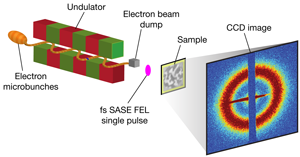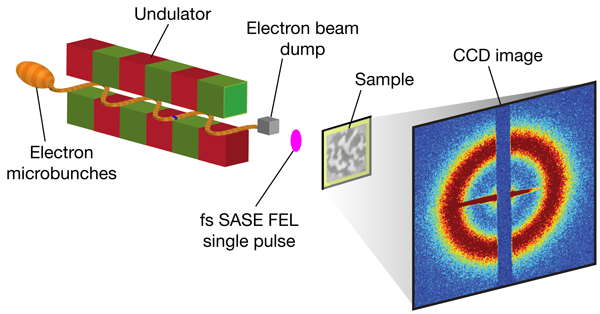Ultrafast probes for ultrasmall magnets
Fundamental solid-state physics and electronics have progressed enormously in the last 50 years and this progress can be characterized by the words “smaller” and “faster.” This is particularly evident in magnetism as the size of bits in magnetic recording technology is now approaching 100nm, while the writing time in laboratory studies has reached 100ps. Naturally, understanding sub- 100- ps, magnetization dynamics at a sub- 100- nm scale has become an issue of vital importance for further development of the $50 billion per year magnetic industry.
Can magnetic bits be smaller and written faster? What are the ultimate limits on size and speed of magnetic switching? Spin switching between two states can be considered as a first-order magnetic phase transition. Assume that a magnet is excited by a very short subpicosecond stimulus with duration much shorter than the time of thermal equilibration in the spin system ( ∼100ps). Such a pulse brings the medium into a strongly nonequilibrium state, where a conventional description of magnetic phenomena in terms of thermodynamics is no longer valid, a macrospin approximation (in which many spins are assumed to behave as one) fails and the dynamics becomes stochastic [1].
The first experiments on magnetic switching with subpicosecond pulses of magnetic field or near-infrared lasers have fully confirmed these expectations as the observed magnetization dynamics was totally different from scenarios that rely on classical magnetism [2–4]. The theoretical analysis of ultrafast magnetic phenomena appears to be extremely challenging. Experimental studies of the ultrafast dynamics of a stochastic process in a sub- 100- nm magnet are very demanding as well. Indeed, the stochastic character of the studied process excludes the possibility of averaging in the experiment. This basically means that for such a study one would need to obtain a magnetic image of a sample within a picosecond period of time and with sub- 100- nm resolution.
So far, there has been no method that would satisfy these requirements. Spin-sensitive scanning probe microscopy, for instance, may reach sub- 100- nm spatial resolution but it has very poor temporal resolution. It is also not suitable for the investigation of stochastic processes: the procedure of taking an image from a sample may take seconds or even minutes. As a result, ultrafast magnetization dynamics at the nanoscale is an unexplored area—the terra incognita of modern magnetism.
Christian Gutt and colleagues at the FLASH free-electron laser facility at the Deutsches Elektronen-Synchrotron (DESY) in Hamburg, Germany, in collaboration with scientists from several research institutes in Berlin, Hamburg, Heidelberg, Remagen, and Karlsruhe report an experimental approach that may initiate a revolution in understanding ultrafast magnetic phenomena at the nanoscale. Writing in Physical Review B they show that by using one single 30fs laser pulse it is possible to probe sub- 100- nm magnetic domains in a Co/Pt multilayer sample (Fig. 1) [5]. In fact, Gutt et al. have demonstrated an ultrafast probe of sub- 100- nm magnets and thus have found a key to enter the uncharted world of femtosecond spin dynamics at the nanometer scale. How did this become possible?
Progress in understanding nanoscale magnetization dynamics has been inseparably linked to the development of x-ray spin-sensitive methods as well as pulsed sources of Roentgen radiation. Thanks to Michael Faraday, who discovered the effect of magnetization of a medium on the polarization of light [6], magneto-optics in the visible spectral range has become one of the most popular tools for studies in magnetism. However, as dimensions enter the nanoscale below 100nm, visible light is no longer effective and one needs shorter wavelength x rays to see the magnetic nanoworld. Just 50 years ago it was difficult to imagine that time-resolved x-ray magnetic spectroscopy at the nanoscale would ever exist. Since x rays were generated mainly by x-ray tubes, only low intensity, incoherent as well as nonpolarized radiation was available. Nevertheless, x-ray sources have improved dramatically, and starting in the 1990s, advanced synchrotrons have been able to produce bright 50ps pulses of polarized x rays. Using such sources, considerable progress has been achieved in understanding nanosecond magnetization dynamics at the sub- 100- nm scale [7]. However, even these new synchrotrons are hardly helpful in the study of sub- 100- ps magnetization dynamics at the nanoscale since for this purpose much shorter pulses of intense x rays are required.
The recently launched free-electron laser at the FLASH facility in Hamburg is the first soft-x-ray laser in the world. This novel x-ray source is able to generate 30fs pulses of polarized and coherent soft-x-ray radiation with about 1012 photons per pulse. The short pulse duration, brightness, coherence, and well-defined polarization of the x-ray radiation are the main ingredients that may allow realizing femtosecond single-shot visualization of sub- 100- nm magnetic domains [8]. In particular, it has been shown that if an ultrashort, bright, and coherent x-ray pulse illuminates a sample, the resulting far-field diffraction pattern will encode the image of the sample [8,9]. The image can be reconstructed from the pattern at the diffraction-limited spatial resolution. The temporal resolution of such an imaging is given by the duration of the pulse.
One should remember that such an approach requires very short and very bright x-ray pulses and the large amount of energy deposited into the sample will ultimately turn it into a plasma. Nevertheless, three years ago Chapman et al. demonstrated that the destruction of the sample is not an obstacle for ultrafast “flash diffractive imaging” [9]. It has been shown that an intense 25fs x-ray pulse produces a coherent diffraction pattern before the sample is destroyed. The image of the sample was successfully reconstructed from the pattern.
Gutt et al. have now made the next important step and applied the idea of ultrafast “flash diffractive imaging” for magnetic studies. By tuning the wavelength of the laser to one of the resonances in cobalt, one may achieve substantially different absorption of polarized x rays in the domains with different orientation of spins. Therefore, coherent and polarized x rays will diffract from such a sample and a far-field diffraction pattern will be formed. The authors performed a simple analysis of this pattern, being able to extract information about the size distribution of the magnetic domains. In contrast to the earlier experiments in Ref. [9], Gutt et al. managed to obtain the diffraction pattern without destruction of the sample, although the sample reached peak temperatures of around 600 ° C. A very important finding of these researchers is the fact that the diffraction pattern is formed before the magnetic properties of the sample are altered. Unfortunately, Gutt et al. could not obtain the real image of the magnetic domains. Nevertheless, the technique clearly demonstrates its ability to probe sub- 100- nm magnetic domains with a single 30fs x-ray pulse.
In the near future, I believe this technique, in combination with the newest x-ray facilities coming online (the recently opened Linac Coherent Light Source in Stanford and the European XFEL, currently under construction in Hamburg), will dramatically improve our understanding of ultrafast magnetization dynamics and femtosecond laser control of magnetism. For instance, it has been recently demonstrated that a 100fs circularly polarized near-infrared laser pulse is able to trigger magnetization reversal in a rare-earth-transition metal (RE-TM) alloy along a totally novel and ultrafast route, where the optomagnetic pulse first turns the medium into a strongly nonequilibrium magnetic state with no net magnetization [3,4]. The origin of this strongly nonequilibrium state is not understood. A pump-probe experiment where RE-TM alloy is first excited by a near-infrared, circularly polarized subpicosecond laser and then probed by a single x-ray pulse will provide new insights into the physics of this ultrafast magnetic phenomenon. Note that FLASH generates pulses with duration down to 10fs. This is already comparable with the characteristic time of exchange interaction in magnetic materials. It would be extremely intriguing to employ the elemental specificity of x-ray techniques and probe spin dynamics of TM and RE sublattices on a time scale pertinent to the time of the exchange interaction between them. The ultrafast single-shot x-ray magnetic imaging reported by Gutt et al. may allow us to take a closer look at the ultimate problem in magnetism—the understanding of the exchange interaction itself.
References
- J. Stöhr and H. C. Siegmann, Magnetism: from fundamentals to nanoscale dynamics (Springer, Berlin, 2006)[Amazon][WorldCat]
- I. Tudosa et al., Nature 428, 831 (2004)
- K. Vahaplar et al., Phys. Rev. Lett. 103, 117201 (2009)
- R. Hertel, Physics 2, 73 (2009)
- C. Gutt et al., Phys. Rev. B 81, 100401 (2010)
- M. Faraday, Phil. Trans. R. Soc. London 136, 104 (1846)
- B. Van Waeyenberge et al., Nature 444, 461 (2006)
- S. Eisebitt et al., Nature 432, 885 (2004)
- H. C. Chapman et al., Nature Phys. 2, 839 (2006)





